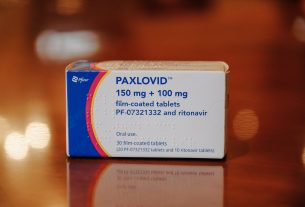The type 2 diabetes drug tirzepatide (better known by its brand name Mounjaro) has recently been authorised by the UK’s medicines regulation authority for use in weight loss and weight management. The decision was made on the same day the US Food and Drug Administration (FDA) approved a version of tirzepatide called Zepbound for weight management.
At the moment, Mounjaro has only been authorised for weight management in people who are obese, or those who are overweight and have weight-related health problems (such as high blood pressure or pre-diabetes). The drug is to be used in combination with lifestyle changes to aid in weight loss.
How does tirzepatide work?
The active ingredient in Mounjaro (which is prescribed for diabetes treatment) is tirzepatide. The tirzepatide formulation for obesity will be given another name. Tirzepatide works in a similar way as semaglutide, which is the active ingredient in Ozempic and Wegovy.
Both semaglutide and tirzepatide are drugs that are modelled on naturally occurring gut hormones called incretins. Incretins are produced by the gut in response to eating. They have a range of effects, including slowing emptying of food from the stomach and increasing insulin levels.
These effects are useful for controlling blood sugar levels in people with diabetes, which is why both drugs have already been licensed to manage type 2 diabetes.
But the reason incretin hormones have garnered so much interest for weight management is because they also produce a sense of fullness after a meal. They do this by signalling to a brain region called the hypothalamus. The hypothalamus then passes the signal on to other areas of the brain, leading to a person feeling full.
Drugs that mimic the action of incretins may cause weight loss because they make a person feel full – making them want to eat less.
How is Mounjaro different from Wegovy?
There are several types of naturally occurring incretin hormones – including glucagon-like peptide 1 (GLP-1) and glucose-dependent insulinotropic polypeptide (GIP).
Mohammed_Al_Ali/ Shutterstock
Drugs that act on GLP-1 receptors have been very successful in treating diabetes since their launch in 2006. In 2020, Saxenda (liraglutide) was the first GLP-1 receptor drug approved to manage obesity. The most recent addition to the family of medicines that act on GLP-1 receptors has been semaglutide, which has been licensed to both manage type 2 diabetes (Ozempic) and obesity (Wegovy).
What makes tirzepatide different is that it acts not just on the body’s GLP-1 receptors, but also on its GIP receptors. This makes tirzepatide a “dual incretin”. Both GLP-1 and GIP release insulin. It’s thought that the two work together, which is why tirzepatide may lead to a greater therapeutic effect.
Is tirzepatide more effective than semaglutide?
Based on data the data we have so far from clinical trials, it appears tirzepatide may lead to greater weight loss when compared to semaglutide.
Trials have shown that a once-weekly injection of 2.4 mg of semaglutide in people who are overweight or obese can lead to an average loss of 15% body weight which persisted for the 104 weeks of medication use.
In comparison, clinical trials of tirzepatide have shown that in people who are obese, a once-weekly injection of the lowest dose of tirzepatide (5mg) leads to a 15% loss of body weight after just 72 weeks. Even more impressively, a once-weekly injection of the highest dose of tirzepatide (20mg) is shown to lead to approximately 20% body weight loss.
Over one-third of participants using tirzepatide achieved weight loss of 25% or more. This is impressive – and greater than the amount of weight loss seen with semaglutide. This degree of weight loss is comparable to that achieved by gastric band surgery.
Other considerations
Patients who are prescribed Mounjaro will be given a one-weekly injection of 2.5mg for four weeks to begin with. After this, the patient’s doctor may then decide to increase their dosage in 5mg increments every four weeks or so, up to a maximum 15mg dosage.
As with other incretin drugs, tirzepatide comes with potential side effects. The most commonly reported ones are constipation, diarrhoea, nausea and vomiting.
Another important consideration with all incretin drugs is that the effects only last as long as the drug is being used. Any weight lost while using the drug may be fully regained within a year of stopping it. Maintaining a healthy lifestyle may help mitigate weight regain somewhat after stopping the drug.
Mounjaro is due to become available early in 2024. It’s authorisation for weight management will be welcome news for many who have struggled to lose weight in the past and those who have weight-related health problems.
What remains to be seen is whether there will be enough supply of tirzepatide to meet demand, which has been an issue with semaglutide over the past year.



